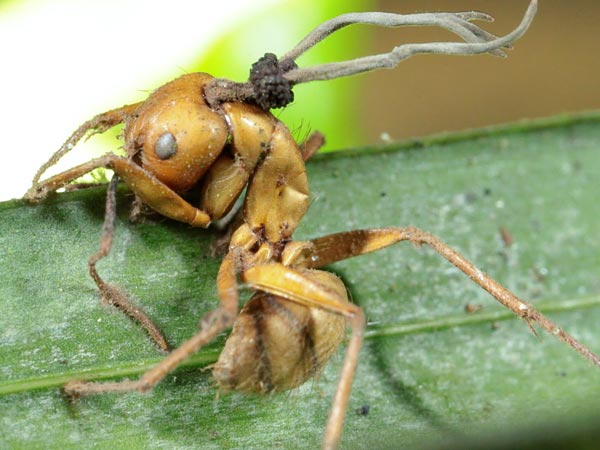
Classification
Humans like to divide and organize their collections. Considering the world consists of millions of organisms, it would be wise to organize for the ease of species naming, identification, and division. Below is the classification of Ophiocordyceps camponoti-balzani.
Domain Eukarya
O. camponoti-balzani belongs to the domain, Eukarya, because it has cells that contain membrane-bound organelles, such as a nucleus. Majority of the organisms you think of are most likely Eukaryotic, and include species like the chicken from Kingdom Animalia, protists such as Toxoplasma gondii, Venus Fly Trap from the Kingdom Plantae, and Schizophyllum commune from Kingdom Fungi.
Kingdom Fungi
Organisms are classified in the kingdom Fungi as a result of several key characteristics. These non-vascular organisms are heterotrophic that digest their food first, then absorb the nutrients. This is all possible due to the digestive enzymes produced by the fungi, which help to break down the intended meal into smaller, easily digestible compounds. These enzymes are capable of digesting not only dead organisms, but also living organisms. As a result, Fungi are capable of being decomposers, parasites , or mutualists. Fungi continue to grow by way of hyphae, which resemble a bed of tiny filaments locked together into a mass called a mycelium. These grow into the spore-producing bodies that release their spores in order to accomplish reproduction, and the continuation of their life cycles.
Phylum Ascomycota
Organisms are classified in the phylum Ascomycota for the spore producing sac called an ascus, which are contained in the fruiting body of the fungi called ascocarp.
Class Sordariomycetes
Classified in the class Sordariomycetes because the fruiting body grows into a flask-shaped stroma. The 8-spored asci is thin-walled and "opened by a pore."
Order Hypocreales
Organisms with brightly colored ascocarps are classified in this order.
Family Ophiocordycipitaceae
Mycobank is a nice fungal database website which classifies organisms from this family because the "stromata or subiculum darkly pigmented or rarely brightly colored, tough, fibrous to pliant, rarely fleshy, often with aperithecial apices or lateral pads. Perithecia superficial to completely immersed, ordinal or oblique in arrangement. Asci usually cylindrical with thickened ascus apex. Ascospores usually cylindrical, multiseptate, disarticulating into part-spores or non-disarticulating."
Genus Ophiocordyceps
Organisms in this genus have all the above mentioned characteristics as well as asci that are hyaline, cyclindrical, and ellipsoidal.
Species Ophiocordyceps camponoti-balzani
Organisms are classified as Ophiocordyceps camponoti-balzani when the fungus Ophiocordyceps unilateralis (Clavicipitaceae: Hypocreales) infects a member of the Camponotini (Formicinae: Formicidae) tribe. Ophiocordyceps camponoti-balzani is one of four ant species infected by this fungus. Each of the species are named for the species of ant infected.